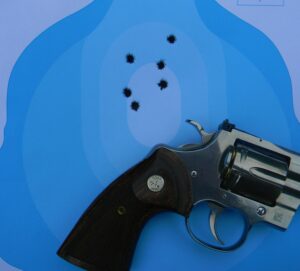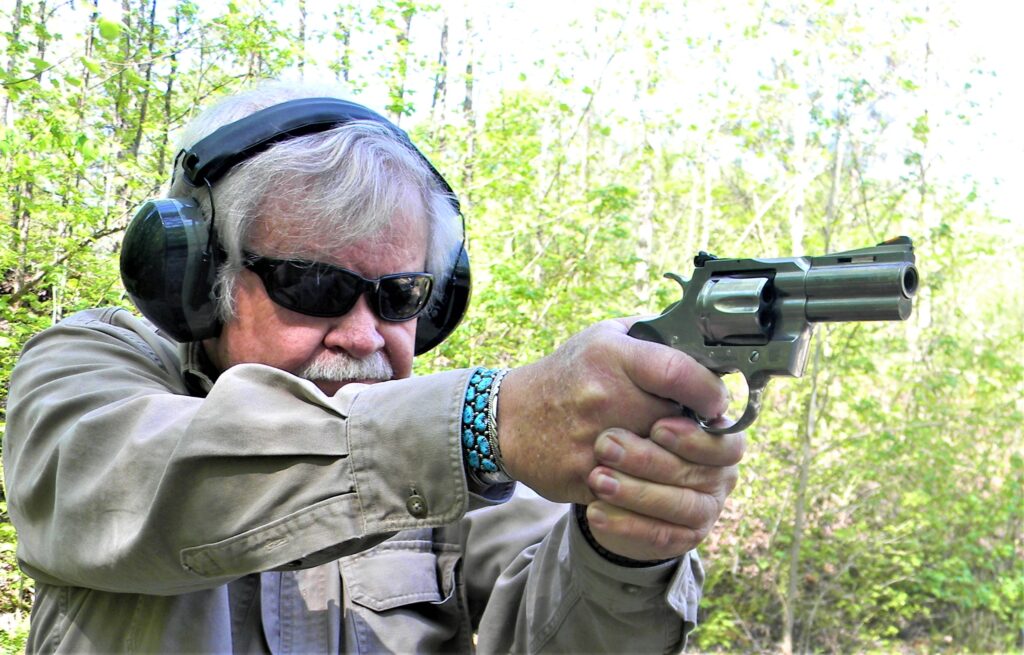
By R.K. Campbell | Contributing Editor
The Diamondback, Python and Cobra revolvers are often affectionately called Colt’s “Snake Guns,” with the Python being what many consider the Cadillac of double-action revolvers.
When it went out of production a generation ago, hearts were broken and available specimens have been trading at gun shows ever since for many times what the original owners paid for them.
And then Colt resurrected the Python, in stainless steel with some key improvements, and this snake has a bite!
The newest Python incarnation is one with a great deal of bling. That is what the old folks call class. Since the introduction of the new model Python a few years ago the revived revolver has earned quite a following. I have owned and fired four- and six-inch barrel examples with excellent results. They are well made and nicely finished. Grips are excellent and the revolver has been beefed up from the original. While I own a 1969 example I have to say the newer guns are even smoother. These are not collector guns but shooters made for shooters.
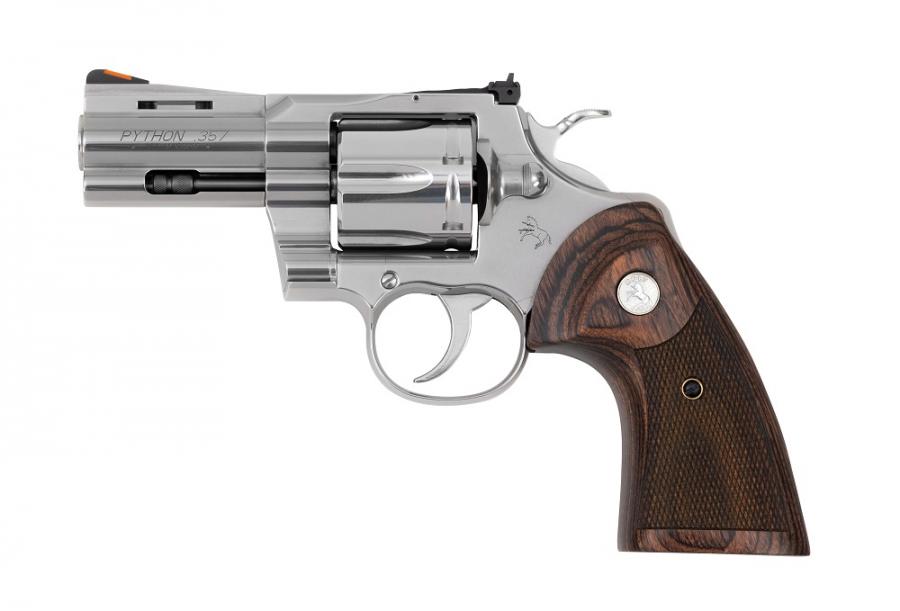
The original run of Colt Python revolvers included a 2 ½-inch barrel revolver. It is a striking handgun and rarer than the four- and six-inch models. It is well balanced and a good shooter.
The newest Python is a short barrel revolver on the same theme. This revolver features a three-inch barrel. The slightly longer barrel results in a good balance.
The ejector rod is longer than the 2 ½-inch revolver in the original line up making for more positive ejection of spent cartridge cases. While .38 Special ammunition was usually ejected smartly with the original short barrel Python, the longer Magnum cartridge cases were not as easily kicked out of the chambers. As I said, this is a shooter for shooters.
The three-inch Colt Python .357 Magnum balances well at 38 ounces. The action features a smooth ten-pound double action trigger and a crisp four-pound single action break. When firing the Colt action versus the Smith & Wesson, Ruger, or Taurus, a word of caution: learn how the Colt operates and how to run the trigger properly.
Colt’s V spring powers both the hammer and trigger. If you are not used to the Colt action you may tie the gun up. This occurs when the trigger is pressed through the action cycle but the trigger is not allowed to completely reset. A number of shooters, even writers, reported the new Colt “locked up.” Simply release the action to unlock the gun. If the Colt trigger is not allowed to fully reset and the trigger is pressed hard in the locked position you may even warp the hand, the part which rotates the cylinder.
Do your dry fire with a triple checked unloaded Colt against a backstop. You will be rewarded with fine accuracy in the double action mode once you master the Colt action.
The Python is a mid-size revolver larger than the Smith & Wesson K frame and smaller than the Smith & Wesson N frame. It is similar to the Smith & Wesson L Frame revolver or the Ruger GP 100. This makes for an optimum size for handling, speed, shooting, concealed carry and handling Magnum recoil. The Colt Python features a trademark ventilated barrel rib and superb fully adjustable rear sights.
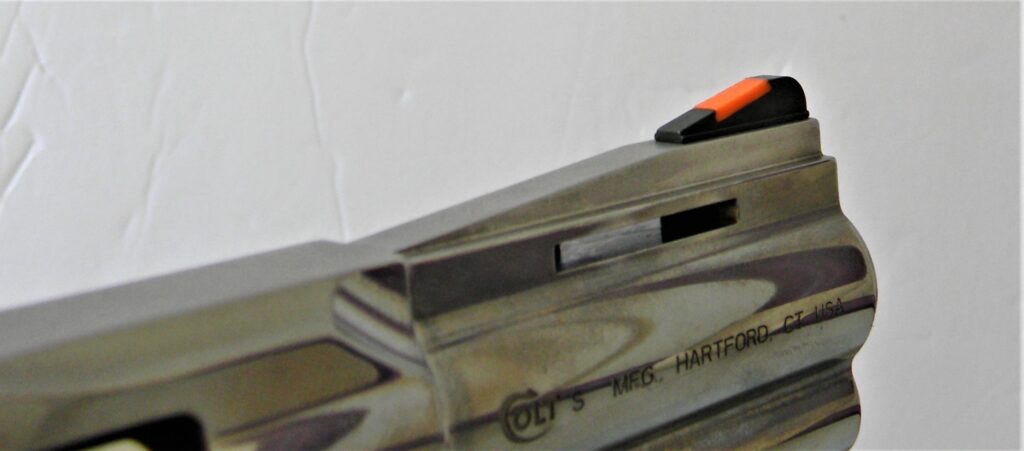
Most of the ammunition I have fired in the three-inch Python has been .38 Special, from handloads to factory generic loads. Accuracy has been good to very good. A load I managed to find in bulk is the Remington .38 Special 130-grain FMJ. I am used to lead bullets and handloads and was skeptical of this round at first. After firing several hundred shots I find it a mild clean burning load with good accuracy. The full metal jacketed bullet alleviates much of the demand for cleaning the barrel after firing lead bullet handloads.
The Python is fast from concealed carry and gets on target quickly. Aim and press the trigger smoothly to the rear. Don’t concentrate on the trigger; you should have that mastered from dry fire. Concentrate on keeping the front sight on the target. Press the trigger with the sights properly aligned and you will hit the target.
I fired the Python at typical combat targets from 7 to 20 yards with good results. The weight, balance, sights and trigger add up to good results. Of course this is a Magnum and you should practice with Magnum ammunition and take advantage of its power. The 800 fps .38s are nice, but magnum loads are for real work.
I loaded the Remington .357 Magnum 125 grain JHP. Checking velocity over an RCBS Chronograph gave a consistent 1,407 fps, about 50- fps less than the four-inch barrel. This is among our most proven personal defense loads, and muzzle blast and recoil are controllable. The Python simply hangs on the target.
As for bench rest accuracy, the following table and notes shows the result of average three-shot groups at 25 yards.
The Python is a classy revolver and good all-around defense handgun. It is suited for home and personal defense and also animal defense. It is a go anywhere do anything handgun in the finest sense of the phrase.
Leather
I used the Wright Leather Worlds Marshal for carrying the Python during the test.
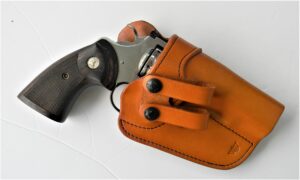
This holster is well made of good material and holds the Python high on the belt. A good, fast draw is possible and the Marshal makes a comfortable secure platform for a rapid presentation.
For carry underneath a pulled out sport shirt the Wright Leather Works Cruiser inside the waistband holster buries the handgun inside the pants. Most of the handgun is concealed by the pants and only a light covering garment is needed. These are first class concealment holsters with much to recommend.
Test Results
(Firing from the MTM K Zone shooting rest at 25 yards).
Load Velocity Group size
Rem. 125 gr. Golden Saber 1,240 fps 1.5 in.
Rem. 125 grain JHP 1,407 fps 2.5 in.


